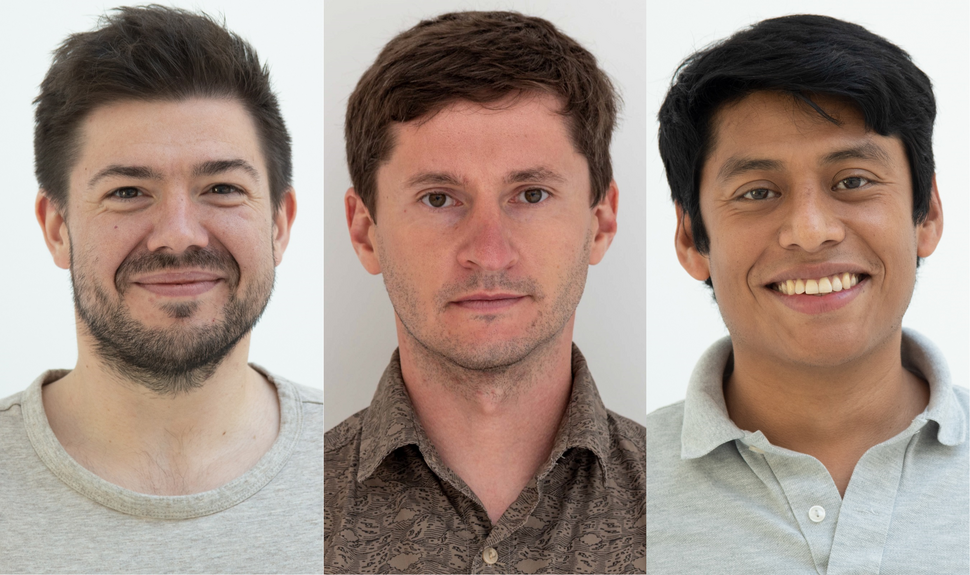Three MPL researchers receive awards
Three scientists from the Max Planck Institute for the Science of Light (MPL) in Erlangen - Paul Roth from the Russell emeritus group and Alexander Mikhaylov and Tomás Santiago-Cruz from Maria Chekhova’s group - recently received awards for their outstanding research at international conferences. Here are some details about the prizes and the related work.

Paul Roth, Alexander Mikhaylov, Tomás Santiago-Cruz. Photo: MPL
Paul Roth OSA Student Prize at CLEO/Pacific Rim 2020
The technical program committee of the Conference on Lasers and Electro-Optics (CLEO)/Pacific Rim 2020 selected Paul Roth for an OSA Student Prize for his paper entitled “Supercontinuum Generation with Circularly Polarized Vortex Modes in a Chiral Three-Core PCF”.
A supercontinuum is generated when laser light with a relatively narrow range of wavelengths is dramatically broadened by nonlinear optical effects, as is seen in photonic crystal fibres. Supercontinuum light is used in microscopy, spectroscopy, optical coherence tomography, and high precision optical clocks. It is however especially challenging to produce a supercontinuum that is circularly polarized, i.e., in which the electric field of the light rotates with time.
Paul Roth, now postdoc in the Russell emeritus group, and his colleagues produced a chirally twisted photonic crystal fibre with a threefold rotationally symmetric core. Through its remarkable ability to preserve circular polarization state, the ultrabroad supercontinuum generated in this fibre is circularly polarized across its entire spectrum. Circularly polarized light has important applications for example in the spectroscopy of chiral molecules such as proteins, and in optical manipulation of microparticles.
Alexander Mikhaylov, best poster / Heraeus Seminar “Sensing with Quantum light"
Alexander Mikhaylov received the price for the best poster at the Heraeus seminar “Sensing with quantum light”. His contribution was about “Two-photon excitations with time-energy entangled photon pairs“.
Two-photon excitation microscopy is a versatile tool for the investigation of many different cellular structures. Especially, when the cells of interest are buried deep within the surrounding tissue and conventional microscopy is of no use anymore. Here, two light particles (photons) with low energy hit the sample almost simultaneously and cause a molecule to emit another photon – it fluoresces. This enables researchers to gain access to properties of different cell structures as for example cells in the immune system or lymph nodes as well as tumor cells. However, the simultaneous impact of two photons is a very rare event causing the need of highly intense laser light. This itself, however, leads to radiation damage in the investigated cells.
Alexander Mikhaylov and his colleagues in the research group of Maria Chekhova, therefore investigate the use of entangled photons. These are two quantum mechanically coupled photons, whose properties are inseparably linked like the two sides of a medal.
“Although the basic idea has been around for many years and the experimental concept is rather straightforward, the measurement itself is quite challenging” says Alexander Mikhaylov. “Several groups claimed to observe a gigantic enhancement using entangled photons that attracted a lot of attention worldwide but many fundamental yet highly experiment relevant questions remain unclear, which can limit the applicability of this novel technique”. Alexander Mikhaylov and his fellow researchers from the US (NIST and CU Boulder) investigate the details of the process of entangled two-photon absorption and in particular several processes that might overshadow the actual two-photon signal and therefore cause some confusion. He continues: “We provided several examples of additional tests that must be carried out to prove 'the two-photon origin' of signals measured with entangled photons. Although at the moment we are on ‘a conservative side’ of how quickly this technique can be practically implemented, we hope our result will inspire further interest in the field and will stimulate new collaborations amongst physicists, chemists and biologists”, concludes Alex.
Tomás Santiago-Cruz, best student talk at the European Optical Society Annual Meeting
Tomás Santiago-Cruz won the prize for the best student talk at the annual meeting of the European Optical Society for his contribution “Spontaneous photon pair generation in nonlinear metasurfaces“.
Optical metasurfaces provide an enormous potential for manipulating the properties of light, as for example propagation direction, polarization or wavelength. They help in significantly reducing the dimensions of optical components, that are used in microscopy, medical diagnostics and portable consumer devices. Depending on the application, these surfaces are made of various materials. However, they are always extremely thin, with dimensions comparable to the wavelength of visible light. They often exhibit structures on the nanoscale, which influence the properties of incoming light and might thus, step by step, replace large optical devices, which are difficult to produce and to align for the evermore shrinking consumer devices.
Tomás Santiago-Cruz and his colleagues in the independent research group of Maria Chekhova are interested in a particular application of metasurfaces. They use these novel materials to produce entangled photons. These are two light particles, whose properties are inseparably linked, like the two sides of a medal. The scientists were able to manufacture nanostructured metasurfaces made of lithium niobate that spontaneously split the photons of an incoming light beam into entangled photons, highly demanded in applications such as quantum cryptography as well as spectroscopy. They were able to increase the production rate by two orders of magnitude and to control the spectrum of the produced light, leading to a paradigm shift in their research field.
Contact
Edda Fischer
Head of Communication and Marketing
Phone: +49 (0)9131 7133 805
MPLpresse@mpl.mpg.de





